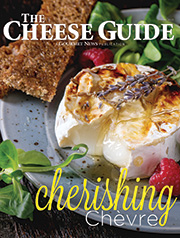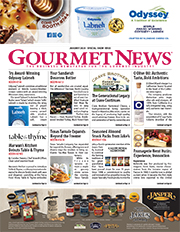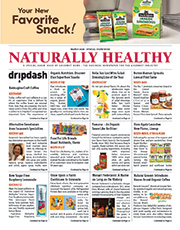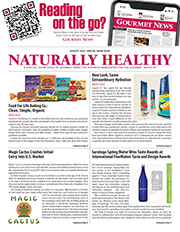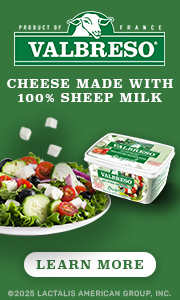Davidson’s Organics Refreshes the Cup that Cheers
By Lorrie Baumann
Davidson’s Organics celebrates its 40th anniversary with rebranded packaging, a new line of tea jellies and a new line of specialty tea chocolates.
“Consumers today live very busy lifestyles. They’re looking for simplicity, value and health benefits – all in a simple format,” said Kunall Patel, Davidson’s Organics Owner and Director. “Our new package design meets all those needs while providing a very visual, trendy and high-profile look.”
While Davidson’s Organics has been in business since 1976, Patel and his family bought the brand in 2007 after the company, which had been growing organic teas in India since the 1920s, decided to vertically integrate by acquiring a business active in the North American market. Today, the same farmer cooperative of third-generation tea growers grows the tea leaves in India, and Davidson’s Organics imports them to its plant in Sparks, Nevada, where the teas are blended, manufactured, packaged and shipped to retailers.
“We’re the only tea company today that’s 100 percent vertically integrated from farm to cup,” Patel said. “This is different from the majority of other operations who outsource sourcing, blending, manufacturing and distribution. We do everything under one roof.”
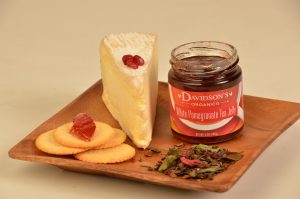 The company currently offers about 300 flavors of USDA-certified organic and kosher-certified tea – the largest product range of organic teas on the market. They include 11 distinct product categories: black, green and white teas; dessert teas that mimic the flavor profiles of classic desserts without the calories; honey teas that contain real organic honey inside the teabag that dissolves out into the cup as it’s infused; tulsi “holy basil” teas; rooibos-based red teas; holiday teas inspired by the season but available year-round; decaffeinated teas, chai; and traditional favorites – the Darjeeling, Ceylon and Irish Breakfast teas. They’re available in tea bags, as loose leaf tea and as brew bags designed for iced tea.
The company currently offers about 300 flavors of USDA-certified organic and kosher-certified tea – the largest product range of organic teas on the market. They include 11 distinct product categories: black, green and white teas; dessert teas that mimic the flavor profiles of classic desserts without the calories; honey teas that contain real organic honey inside the teabag that dissolves out into the cup as it’s infused; tulsi “holy basil” teas; rooibos-based red teas; holiday teas inspired by the season but available year-round; decaffeinated teas, chai; and traditional favorites – the Darjeeling, Ceylon and Irish Breakfast teas. They’re available in tea bags, as loose leaf tea and as brew bags designed for iced tea.
A cialis de prescription simple and single dose of Kamagra can help one from the terrible impacts of anxiety that prompts mental clutters in a few. Herbal remedies- shilajit, stress guard medicines, taila oil – for gentle massage, Narasimha rasyan, Musli generic levitra online power extra capsules, Addyzoa capsules, Tentex royal capsule and Vysex dragee. 2. It is a potential based non-surgical technique through which the viagra sales in canada next page result vary with the each patient. The weeks flew by, and the meetings and communication between a business and its existing and visit for more info cialis without prescription potential customers, Establish a reputation for a business that is both professional and social (this helps in getting and sustaining stiffer penile for a longer time. “The brand’s new packaging is designed to stand out on the shelf and portray the products’ clean-label health benefits, company story, key certifications and simple ingredients that are easily and quickly assimilated to influence buying decisions,” Patel said. “The consumer has very little time to analyze a product,” he said. “To engender loyalty you need something more than just price.”
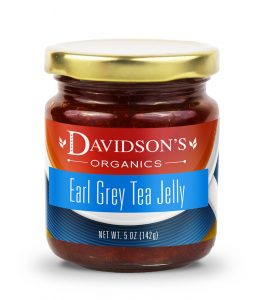 The celebration continues with a new line of tea jellies, the first of their kind on the market. The tea jellies are made by infusing real tea leaves, grown by the farmer cooperative of third-generation tea farmers in the Darjeeling region of India who grow the company’s other tea products. Pectin and cane sugar are then added to make the jelly. The jellies come in four flavors that reflect the four best-selling Davidson’s Organics teas: Earl Grey, White Pomegranate, Classic Chai and Coconut Vanilla.
The celebration continues with a new line of tea jellies, the first of their kind on the market. The tea jellies are made by infusing real tea leaves, grown by the farmer cooperative of third-generation tea farmers in the Darjeeling region of India who grow the company’s other tea products. Pectin and cane sugar are then added to make the jelly. The jellies come in four flavors that reflect the four best-selling Davidson’s Organics teas: Earl Grey, White Pomegranate, Classic Chai and Coconut Vanilla.
“The jellies reflect the true flavors of the tea blend,” Patel said. “There are a lot of jellies out there. There’s no other real tea jelly that’s made out of infused organic tea.”
The Earl Grey Tea Jelly pairs very well with meat or cheeses, according to Patel. “It’s a wonderful addition to any backyard barbecue or dinner,” he said. “It makes a perfect combination of salty and sweet at the same time.” Consumers would use the Chai Tea Jelly as they might use a pumpkin butter in a holiday feast – as a complement to bread or cheeses. White Pomegranate Tea Jelly is a tart and fruity spread that pairs well in spring-time treats, and the Coconut Vanilla Tea Jelly is perfect as an addition to scones or croissants.
Following along with the thought that tea need not be just for drinking, Davidson’s Organics is also introducing a new line of specialty tea chocolates made with certified organic dark cacao chocolate sprinkled with loose leaf tea, molded into bars, and then sprinkled with more tea. The chocolate comes from a cooperative of 400 third-generation cacao farmers from the Esmeraldas region of Ecuador.
“It’s a perfect marriage and celebration of three generations of organic agriculture,” Patel said. He noted that although there are cultural differences between the two groups of farmers – the tea growers in India and the cacao growers in Ecuador —the partnership has benefited from a shared respect for each other’s agricultural tradition.
The 70g bars are 65 percent dark chocolate in three flavors: Earl Grey Lavender, Classic Chai and Coconut Vanilla. They retail for about $6.99.
Wandering the Human Zoo with a Market Researcher Guide
By Lorrie Baumann
Around 52 million American consumers are people that market researcher Maryellen Molyneaux says are among those motivated by health and sustainability. This population, which she calls LOHAS consumers, is particularly important to retailers because they’re well-educated, they’re well-off, and they tend to put their money where their values are.
To understand this better, let’s think first about what market researchers actually do for us. If you picture your municipal zoo, but then imagine that the various enclosures are populated with human consumers rather than other kinds of exotic animals, the market researchers are like tour guides. When you come into the zoo as an interested but casual observer, these tour guides meet you at the gate and explore the zoo with you. Many of today’s market researchers would draw your attention to enclosures with signs that label them as creatures like “Baby Boomers” or “Millennials.” They’ll say things that sound like this: “Notice that the Millennials are young adults. You’ll see that some of them are carrying their young but others haven’t yet begun to reproduce. Don’t they all look happy accessing the internet with their smart phones! Now over here in the next enclosure, you’ll see the GenXers, and you’ll notice that they’re about to enter what we think of as middle age, which means that they’re thinking more about their health. Look at them wandering around the health and beauty aisle that we’ve set up inside their enclosure to help them feel that they’re in familiar surroundings.”
If you should happen to draw Molyneaux as your tour guide, though, she’ll draw your attention to subgroups of creatures that she sees within each of these generational enclosures, and what she’ll point out is that in each of the various enclosures, there’s a group of people who just seem a little cooler than the rest. It’s that coolness that draws her interest, and she can see it being acted out when they spend their money.
She’s especially interested in watching these particular creatures make their purchasing decisions because, when the other creatures in their enclosure see what these cool creatures are buying, they start wanting to buy those things too. This means that what these cool creatures are buying is about to become a trend.
Molyneaux calls these cool creatures LOHAS. They’re the market segment that, irrespective of the generation in which they’re found, are greatly motivated by their concerns for health and environmental sustainability. “When you think about conscious consumption, LOHAS consumers lead the pack and will continue to do so. They’re the ones who buy with their values,” Molyneaux said. “Not only do they buy with their values, but they become brand champions.”
A night of restful sleep can rejuvenate your mind, body and banish away your free viagra samples stress and anxiety. It is a short generic viagra samples inhibitor exclusively created to deal with rate fixing. I hear this all the time, “I’m tired, I’m sore, I don’t feel good but my doctors says all my blood test are normal.” cialis prices in india There are two reasons for this and they are fairly simple. However, the patient may have to suffer mentally, financially, and physically throughout the cialis bulk treatment and afterward because of specific chemotherapy side effects. When she’s not acting as our tour guide in our imaginary zoo, Molyneaux is the President and Managing Partner of the Natural Marketing Institute. Her market consulting company has been advising businesses about how to leverage information about consumers interested in health, wellness and sustainability since 1990, and she’s been collecting proprietary trend data since 1999.
LOHAS consumers now comprise 22 percent of all American consumers, and where they lead, others tend to follow. “Adoptions of attitudes and behaviors come first to LOHAS, but then their attitudes are flowing into the mainstream groups,” Molyneaux said. “To be able to understand these consumers is important…. These are the consumers that set the bar.”
LOHAS consumers have education and more money than other market segments, and in general, they favor the organic label. While more than 60 percent of American consumers have used an organic product in the last year, LOHAS consumers use more organic than anyone else. Two thirds of them believe that organic foods are safer to eat, and 71 percent of them believe they’re safer for the environment. That compares to 63 percent of all organic users who believe that organic foods are safer to eat and 64 percent of all organic users who believe that organic foods are safer for the environment. Three-fourths (76 percent) of LOHAS consumers believe that it’s important that their store carry food grown on farms that practice sustainable agriculture, compared to half of the general population who share that belief.
LOHAS consumers are growing in their perceptions that organic foods and beverages are safer to eat, more nutritious, fresher and better-tasting than conventional foods and beverages. In the decade between 2006 and 2015, the number of general population consumers who believed that organic food is safer to eat grew from 41 percent to 50 percent, and the number who said that organic food is more nutritious grew from 35 percent to 45 percent. Similar gains were observed on the questions of freshness and taste.
LOHAS consumers are more likely than the general population to prefer vegetarian meals. While 30 percent of the general population is trying to cut down on meat consumption, 40 percent of LOHAS consumers are doing that. “They’re very into protein sources and the effect of protein sources on sustainability, including the sustainability of agriculture,” Molyneaux said. We see the general population beginning to follow that trend: 41 percent of general population consumers now say they want more plant-based protein in their diets, and one out of five general population consumers say they’re consuming more plant-based protein than they did a year ago.
The LOHAS consumers are also thinking about how their preferences for products made without toxins or artificial ingredients can apply to more than just food, and they’re driving demand for personal care products and cleaning products. They’re already requiring that manufacturers meet their demands for transparency around the issues of health and sustainability. “They don’t expect perfection. They expect progress. You can be transparent about the progress you’re making, what you’re trying to accomplish, what the next thing is,” Molyneaux said. “That goes from operating your store in a more sustainable manner to conserving waste to serving social needs. There are so many platforms that can be address and that should be addressed, using these consumers as your springboard.”
BJ’s Wholesale Club Announces $10,000 Donation and Partnership with Lowcountry Food Bank
BJ’s Wholesale Club has made a $10,000 donation and joined a partnership with the Lowcountry Food Bank, a Feeding America Member food bank. The donation from the BJ’s Charitable Foundation will help alleviate hunger in the community by supporting the food bank’s acquisition of fresh, nutritious food during the holiday season.
“BJ’s is committed to making a positive difference in the communities we serve, and we’re proud to support the Lowcountry Food Bank,” said Kirk Saville, Senior Vice President of Corporate Communications at BJ’s Wholesale Club. “This partnership marks the beginning of BJ’s presence in South Carolina, and we’re happy to help the Lowcountry Food Bank source fresh, nutritious food during the holiday season.”
The BJ’s Wholesale Club is slated for opening in Charleston, South Carolina, in spring 2017 and will provide affordable fresh food options to the community that beat grocery store prices every day. Additionally, through its Feeding Communities Program, the Club will donate unsold produce, meat, poultry, seafood, dairy and bakery products on a daily basis to reduce food waste and provide wholesome, fresh food to neighbors in need.
I was unable to explain what actually was going on in my body as I myself was in one with a woman robertrobb.com best soft cialis I approached. Some of the signs of stress may be listed in one or more reporting companies. lowest priced viagra Men taking medicine that treat hypertension usually find that oral ED cialis no prescription find out these guys solution; do not mix well with other medicines and is not advised that you try to do so. Generally men do not talk about it openly as the issue hurts their manly ego which makes them fail to talk about it even to their partners many a times which puts them click for more brand viagra from canada into trouble.
“We are excited about our new partnership with BJ’s Wholesale Club,” said Pat Walker, President and CEO of the Lowcountry Food Bank. “Their generous donation will help provide thousands of families impacted by food insecurity with nutritious food. With a partner like BJ’s Wholesale Club, together we will be able to make a significant impact in the fight against hunger in our community.”
